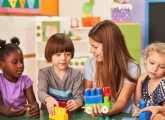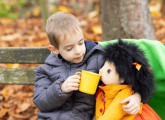Treehouse Preschool’s Play to Learn Library is helping staff to engage with parents, and parents to support their children’s learning, says Kirstine Beeley…
We’re all familiar with the importance of working in partnership with parents to help children’s development – the EYFS states that “Parents are children’s first and most enduring educators”, after all. The question is how to go about it; settings are continuously searching for ways to engage mums and dads, to help bridge the gap between home and setting. One setting I’ve worked closely with recently has developed a unique project that is not only run by parents but is also specifically designed for parents and children to share at home.
Treehouse Preschool in Winslow, Buckinghamshire has always had good relationships with its parents. However, staff had identified an increasing need to inform parents about the way learning took place at the setting, as they found many were asking for more formal ‘reading and writing’ approaches and displaying a lack of awareness of the daily approach within the setting. This situation was not helped by the fact that the preschool shares its building with a separate before- and after-school club, meaning that for many parents the setting was packed away or just being set up when they came to drop off or collect their children. One member of staff, Sarah Laws, had attended ECaT (Every Child a Talker) training and was keen to start sharing her experiences with the parents. She developed a series of simple activity sheets with talking activities specifically for parents to share with their children at home. She could not have foreseen how popular they would be, nor how they would lead to the development of a project that is now recommended across the county as a way of engaging parents in their child’s learning.
The positive response Sarah received about the activities, which included a number picture hunt, listening games and nursery rhyme activities, was overwhelming. Some parents suggested that they would like more ideas of things they could do at home with their children, and so the idea of the ‘Play to Learn Library’ was born.
Determined that the project should be driven by the parents, Sarah approached a few to see if they would be interested in setting up a lending library of books and activities that would provide other mums and dads with ideas about learning through play while highlighting the principles of the ECaT project. The response was positive, and a meeting took place to decide how to get started.
Initially, we looked at developing about 30 bags (enough to cover all of the children in even the busiest of sessions) with a view to eventually developing 60 bags so that every child on roll by the end of the summer could take part in the project.
It was agreed that the system needed to be simple and fun if it was to engage parents and children alike, and we settled on a format of a clear bag containing a book, a related toy and an activity, as well as a card with both talking and learning through play ideas.
With the help of parents, some of whom were teachers, the ideas were drawn together and a list of required books and equipment was posted out to parents. We all felt strongly that getting parents involved at every stage was our best hope of engaging them in the use of the project in the long term. Donations rolled in and the project bags started to come together. I’ll never forget our excitement as we explored our first library bag – it looked really exciting and inviting, and we knew then that the children would want to use them.
Parents were sent an explanatory letter outlining the aims of the project and thanking them for their support in making it happen, and two months after the initial meeting, at the start of the autumn term, 2011, our first ever Play To Learn Library was launched. It was full of colourful bags laid out for parents and children to browse as they came into the setting. Parents were asked to sign an agreement promising to look after the bags and return them in the state they were taken in, and to supervise their use and ensure they were kept away from small children for safety purposes. We had been aware of safety issues from the very beginning and used a combination of signed parental agreement and clear safety labels on the bags to cover the assessed risks.
The feedback we’ve received over the past two years has been amazing, with talk of spaceships, gruffalo cakes, insect hunts and mud pies. The children are really enjoying the chance to try something new at home with their parents, and the parents are really loving the chance to experience a little of what the setting does at home with their children. It’s really nice to see the children enjoying the stories and the activities, and many come back to the same bag time and time again – we’re even looking at doubling up on some of the more popular bags! Each term brings fresh opportunities to introduce the project to new families and to continue to promote the benefits of learning through play.
The number of bags continues to grow; the library is now up to about 60 bags, but plans for development of the project are ongoing, and ideas now being discussed include the possibility of replicating some of the more popular bags for parents to purchase and keep at home, the development of some ‘traditional story’ bags to boost children’s knowledge of these fast-fading tales, and the possibility of lending out library bags to local childminders for use with their children as well. We recently held a Parent Play week with each day based around a familiar book and promoting lots of the fun ideas from within our bags. It was great to see parents mixing up magic porridge in pots and playing with Dirty Bertie’s slime bogies!
Within the setting, the idea of a lending library has also been developed further, and the team are currently gearing up to launch a new scheme of home/setting book loans, similar to a traditional library, to enhance the existing project. We’re proud to say that settings across the county are now enquiring about the project, and many are setting up their own versions.
One thing we’re certain about is that this project would never have happened if it weren’t for the ongoing support of our parents, who donated items, built the bags and manned the lending library. This project is a real reflection of how we can all share and support each other in children’s learning and work truly in partnership.
Initial concerns that things might go missing from the bags over time have proved largely unfounded, with parents and children taking real pride in the bags and their contents. You can’t avoid the odd piece of a game being eaten by the dog, or a toy duck going missing under a bed or the sofa, but these instances are rare – and because the majority of the materials used are donated it’s not such an issue financially.
We try to include activities that are home-made so that replacement pieces can be easily sourced, or where the outcome of the activity is not affected if a piece is lost. We have found that we do need a small pot of funds to maintain well-used bags and replace the odd item, but the benefits to shared learning far outweigh any costs, and our outlay is nowhere near what it would be if we had bought the contents of all of the bags (in fact, if that were the case, this project just would not have happened as the preschool is a small, not-for-profit charitable organisation).
Kirstine Beeley is an independent trainer, author and consultant, with experience of teaching in early years, primary and SEN settings.

Teacher wellbeing – What are you doing about it?
Editors picks

Noise levels – How to keep them down in Early Years
Editors picks

Empathy dolls – Use them to explore big emotions
Editors picks
